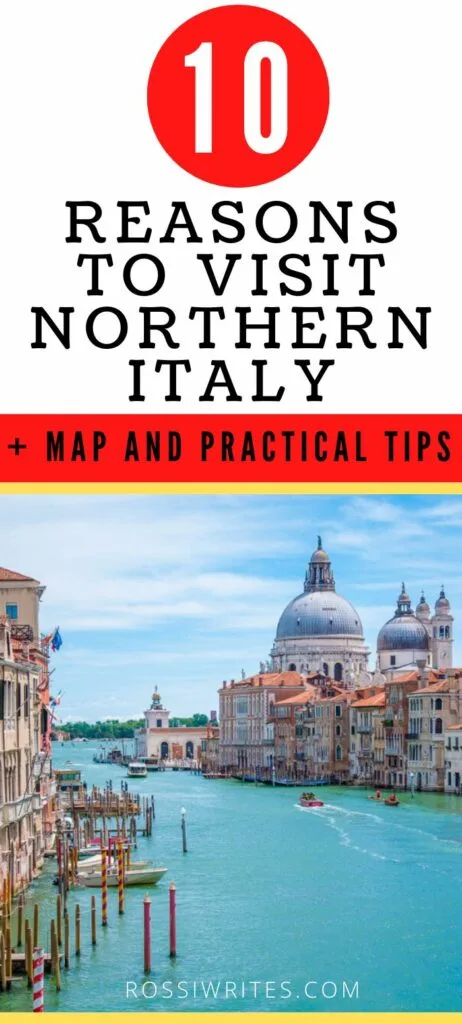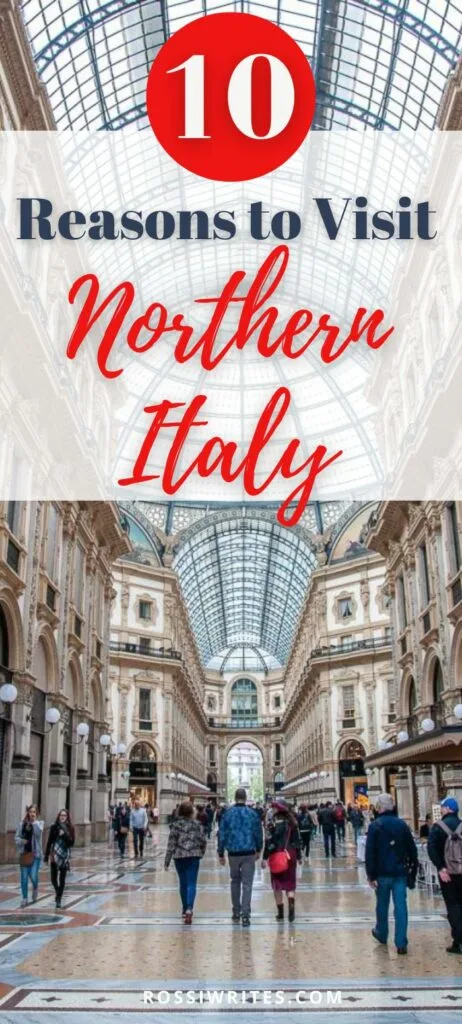Northern Italy is a great place to visit either by yourself or with your family and friends.
No matter what you are after – a city break, a relaxing holiday, or an active vacation – you are bound to find it here and so much more – from history and art to delicious food, a myriad of sports activities, and lively events.

Stretching across the top of the Italian boot, Northern Italy is made of eight regions. From west to east, they are Aosta Valley, Piedmont, Liguria, Lombardy, Emilia-Romagna, Trentino-South Tyrol, Veneto, and Friuli Venezia Giulia.
Many of Italy’s most famous cities are in the country’s north. Among them are Venice, Milan, Verona, Turin, Trieste, Genoa, and Bologna.
Also in the north of Italy, you can visit the always very popular and very picturesque Cinque Terre, Lago di Garda which is Italy’s largest lake, Lago di Como which is Italy’s most famous lake, and the Dolomites – a mighty mountain range which is all the rage for its stunning landscapes and proud craggy peaks.
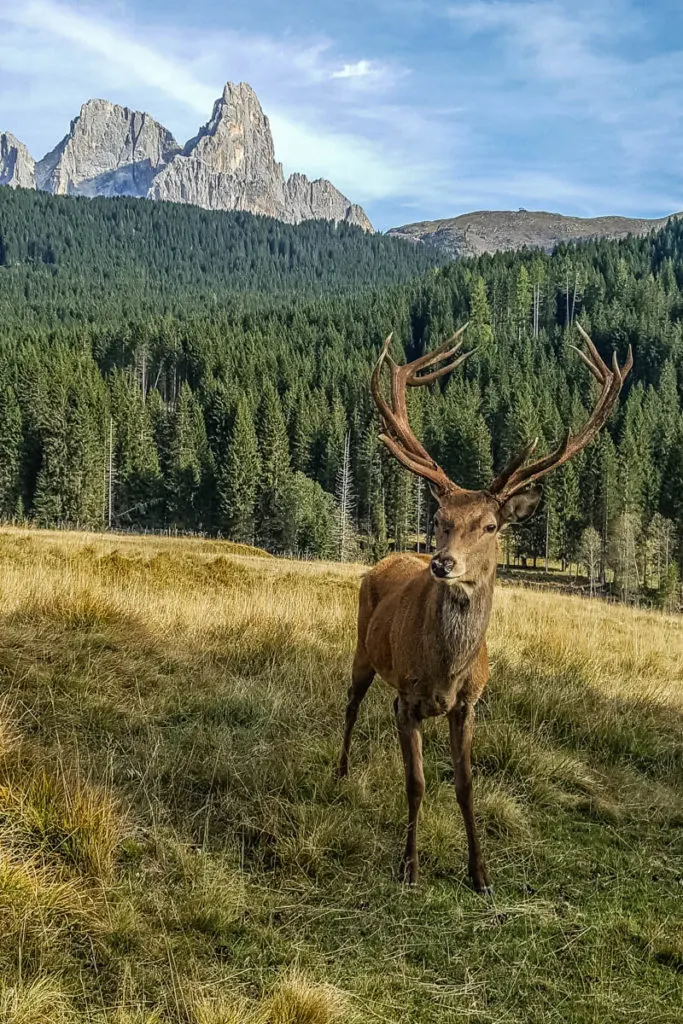
And yet, that’s not all! Rich in hidden gems, culinary delights, and a staggering number of unique landmarks, visiting Italy’s north is a recipe for many wonderful adventures. So, to inspire you to put it on your travel list, today, I will give you ten reasons that make Northern Italy a must-see.
All the detailed information in this blog post is based on my countless trips to Northern Italy over the last almost 20 years. Six of them I actually spent living in Vicenza – a small Northern Italian city halfway between Venice and Verona. Everything I write about herewith is firsthand tried and tested. Now, I am only too happy to pass the word along.
To help your travel planning, I have included a map showing the exact location of Northern Italy in Europe. It also outlines the eight Italian regions that are part of it. Practical tips are peppered throughout the text. I hope that the detailed information, the map, the tips, and the curious details I share with you below will galvanise you to experience Italy’s north for yourself as soon as possible.
Have a look!
Map of Northern Italy with the 8 Northern Italian Regions and Their Capitals
First things first! Let’s start by pinpointing on the map the exact location of Northern Italy and the eight regions it comprises. As you can see Northern Italy spreads across the upper portion of the Italian peninsula and it stands between its calf and the European countries of France, Switzerland, Austria, and Slovenia.
The eight Northern Italian regions are outlined with a different colour each. Their capitals are pinned with blue stars. Here they are:
Aosta Valley (green outline) – known for its mountainous landscapes and ski resorts it has the city of Aosta at its helm.
Piedmont (pink outline) – the land of truffles, hazelnuts, and chocolate has the royal city of Turin as its capital.
Liguria (purple outline) – long, thin, and curved, it’s captained by Genoa and attracts millions of visitors to its cluster of five picturesque villages known as Cinque Terre.
Lombardy (grey outline) – Italy’s most prosperous region is ruled over by the world’s fashion capital Milan.
Emilia-Romagna (blue outline) – the land of delicious food and red-brick buildings is headlined by the city of Bologna with Italy’s oldest University at its heart.
Trentino-South Tyrol (in Italian, Trentino-Alto Adige) (lilac outline) – with strong Tyrolean influences, majestic nature, hundreds of lakes, and autonomous status, this region has two provincial capitals – Trento and Bolzano.
Veneto (red outline) – with well-developed industry and yet countless corners of pristine nature, this Northern Italian region is known predominantly for its capital Venice and hides many gems like Verona, Padua, and Vicenza in its bosom of history and art.
Friuli Venezia Giulia (orange outline) – the often overlooked northeasternmost corner of Italy lately has been attracting universal acclaim on account of its capital Trieste, coffee traditions, and locally produced wines.
How to Use This Map of Northern Italy?
You can use this map of Northern Italy just like any other Google map. You can zoom in and out, or click on the last icon in the top right corner to open the map in a separate tab.
A click on the first icon in the top left corner will open a list with all destinations – both the eight Northern Italian regions and their respective capitals – pinned to the map. Click on any destination to see its coordinates as well as links to accommodation options and (where available) additional information.
You can also use this map to calculate distances and directions from any point in Italy (or abroad) to the eight Northern Italian regions and their many points of interest. If you want, you can share this map of Italy’s north on social media, too.
10 Reasons to Visit Northern Italy – The Land of Venice, the Dolomites, the Italian Lakes, and Exceedingly Delicious Food
Pin for Later!
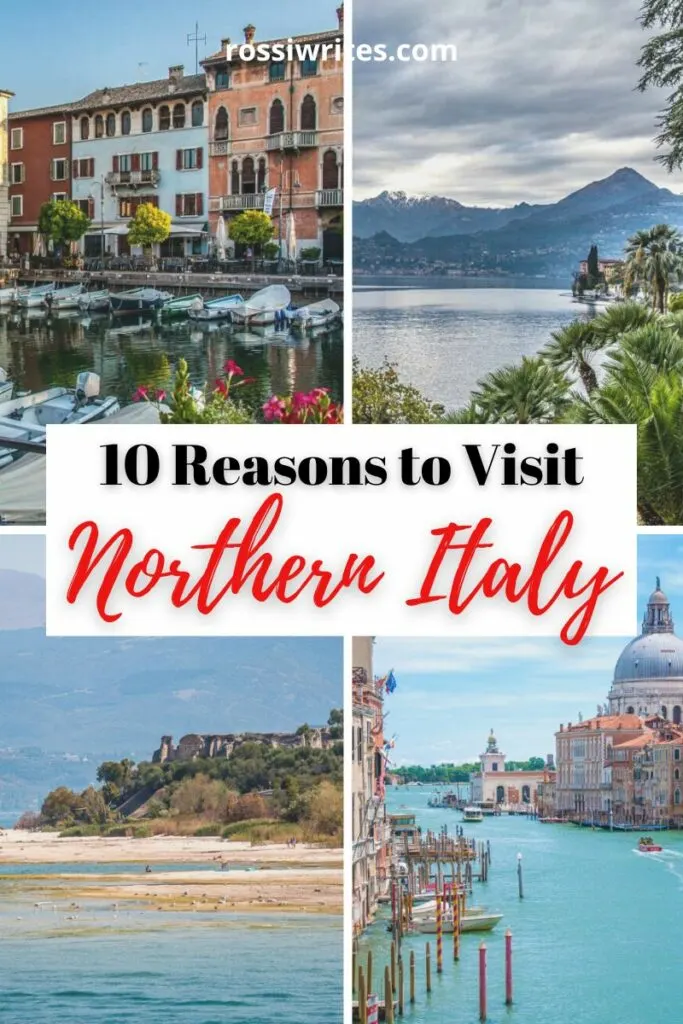
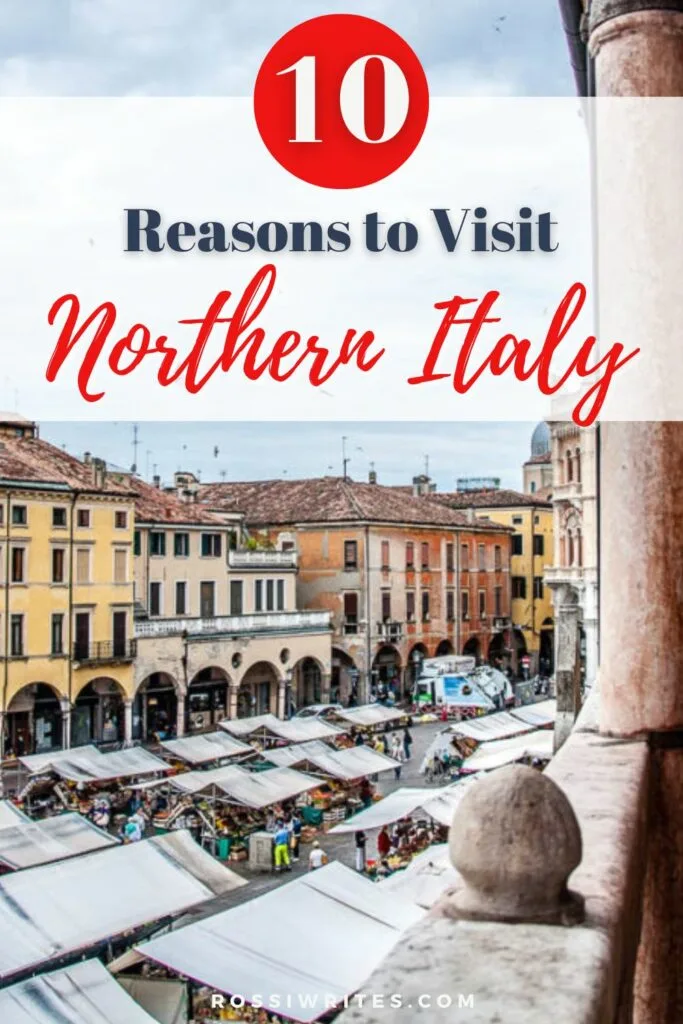
1. Northern Italy’s Many Must-See Destinations

Many of Italy’s most famous destinations are in the northern portion of the country. They are known worldwide and millions of people dream to see them at least once in their lives.
From historic cities to picturesque villages, from stunning landforms to charming lakes, Northern Italy is blessed with many of Europe’s and the world’s most coveted spots. Here they are in a tiny nutshell:
- Historic cities: Venice, Milan, Verona, Bologna, Genoa, Turin, and Trieste;
- Picturesque Villages and Towns: Cinque Terre, Bellagio, Bassano del Grappa, Treviso, and Sirmione;
- Stunning Landforms: the Alps, the northern portion of the Apennines, the Dolomites, dozens of islands in the Venetian Lagoon;
- Charming Lakes: Garda, Como, Maggiore, and Orta form the quartet of the greatest Italian lakes.
With short travel distances and well-organised public and road transport, many of these worldwide famous destinations in Northern Italy can be visited within the span of the same Italian holiday.
They offer a great mix of history, culture, nature, and art. A visit to them is always a good idea and something that leaves travel memories to last a lifetime.
Practical Tips:
Millions of people flock each year to Northern Italy’s most famous destinations. The best time to visit them is, generally speaking, during the shoulder seasons, i.e. April-May and September-October. This is when the temperatures are very pleasant, the sun usually shines bright, and the tourist crowds are just starting to swell or are already past their most voluminous.
The Christmas season is another great window to visit Northern Italy and it’s usually overlooked by the mass tourists. This is when heartfelt celebrations and festive markets are taking place all over the eight Northern Italian regions giving you a chance to experience authentic Nativity traditions.
When visiting famous landmarks and sights in Northern Italy, it’s always a good idea to book your tickets in advance. This way you will avoid queuing on the day and you won’t be disappointed in case all tickets are sold out for the time slot you are interested in. I usually book in advance through Tiqets and Viator – two large platforms specialised in selling tickets for and guided tours of worldwide famous attractions and museums.
Learn More:
Best Cities in Northern Italy, Venice Landmarks, Best Towns on Lake Garda, Travel Guide for Lake Como
2. Northern Italy’s Deep Layers of History and Art
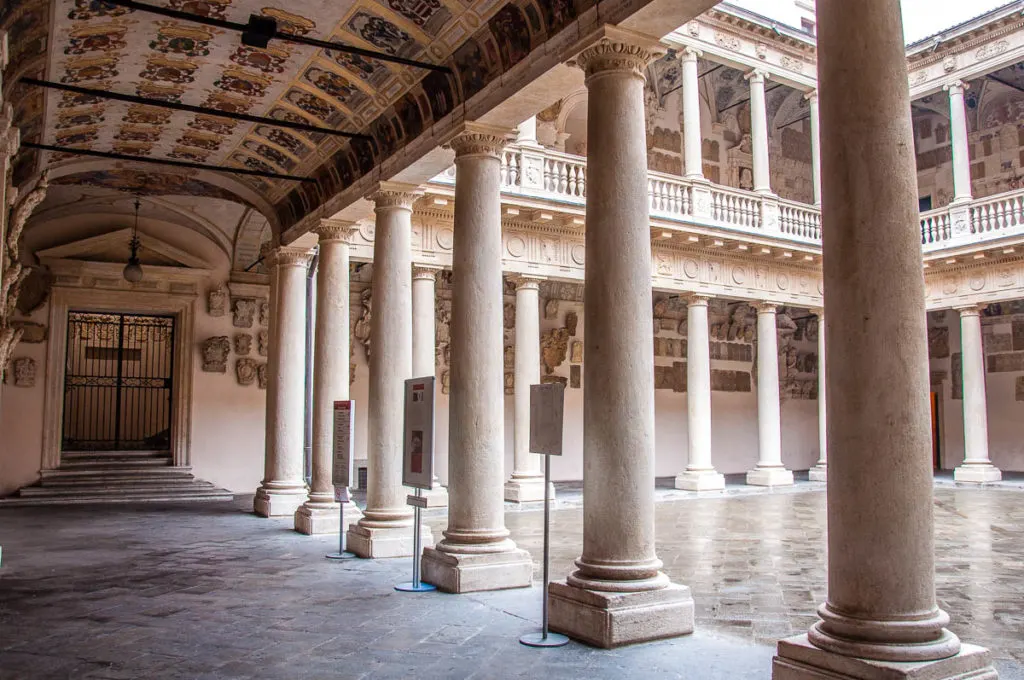
Northern Italy is a must-see corner of Europe if you have an interest in history and art.
Millennia ago, its territory was inhabited by prehistoric tribes many of which had advanced cultures with their own writing systems and intricate crafts. A case in point is the Paleovenetic Este Culture which has left us complex ceramic and metal artifacts. A visit to the National Atestino Museum in the small town of Este in the Northern Italian region of Veneto is an incredible experience if you want to delve deeper into it. Such museums – rich in priceless artifacts and throwing light onto advanced prehistoric cultures – are dotted all over Italy’s north.
When the territory of Northern Italy became part of the Roman Empire, the ancient Romans built majestic public and private buildings, religious temples, and many important roads. Arena di Verona – an imposing amphitheatre that nowadays serves as an exquisite opera and concert venue – is one of the largest surviving Roman structures in the world. A short trip by train away, you also have the monumental ruins of Roman villas on Lake Garda and of Roman temples, a theatre, and private dwellings in the city of Brescia.
Later on, the relations and tensions between the Western and the Eastern Roman Empires also left their imprint on the north of Italy. The mosaic masterpieces of Ravenna and the Byzantine-inspired architecture of Venice are direct references to this historic period.
During the High Middle Ages, Northern Italy was split between many warring factions and dynasties. They built mighty fortresses and castles, several of which still stand and can be visited nowadays. The medieval castles around Lake Garda – many of which were erected by Verona’s Scaliger dynasty – are among Europe’s most impressive medieval fortifications.
The High Middle Ages is also when the first two Universities were founded in Italy. First in Bologna in 1088 and then in Padua in 1222. Today, their historic buildings are open for visits. It’s one of the highlights of a trip to Italy’s north.
The Renaissance tightly embraced Northern Italy. The Renaissance cities of Venice, Vicenza, Mantua, and Ferrara flourished. Priceless works of art were created by the artists of the local branches of the Italian Renaissance with the Venetian School particularly well known. A cultural and scientific exchange between the city-states of Northern Italy and the cities and the states of Northern Europe propelled forward the development of art, medicine, and science.
And then the new history of Italy from its Unification in the 19th century throughout the two World Wars to our days makes for yet another fascinating topic to explore during your visit to the eight Northern Italian regions.
Practical Tips:
Travel off the beaten path to fully experience the wonders of Northern Italy’s history and art. Everyone wants to see seminal works of art like Leonardo da Vinci’s Last Supper in Milan but there are so many more masterpieces here that are not necessarily in a major landmark or museum. Explore the small Northern Italian towns, enter every church that you come across, and visit small, local museums and sights.
Soon, you will notice how your understanding of Italy’s art and culture grows and deepens, how your appreciation for a work of art doesn’t depend anymore simply on name recognition. We are too used to narrowing history and art down to a couple of dozens of events and names. One of the best things about travel in Northern Italy is that it helps you look beyond these limitations and experience things on a deeper level.
Learn More:
Italy’s Historic Universities, Venice for Art Lovers, Looking Slowly in Italy
3. Northern Italy’s Well-Organised Transport System
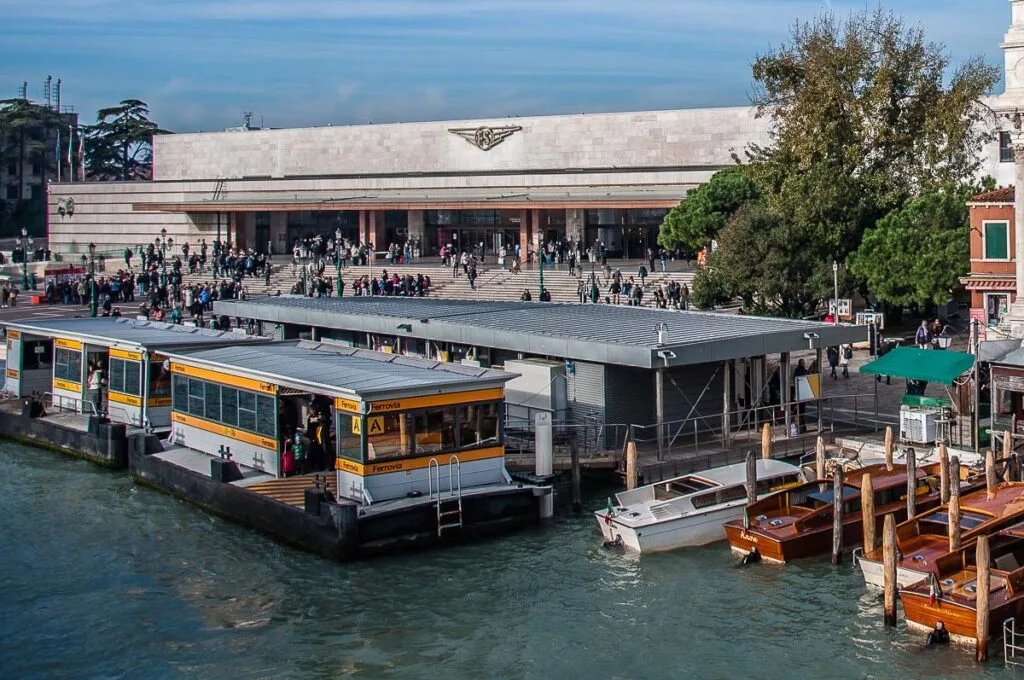
Northern Italy is incredibly easy to get around. Served by almost a dozen major airports, the northern strip of the country is quick to reach from anywhere in Europe and the world.
Once arrived, you can then rely on a well-organised transport system to take you anywhere by railway and/or road – from the main tourist magnets like Venice and Cinque Terre to historic towns like Ravenna, Cittadella, and Palmanova.
High-speed trains – Frecciarossa, Frecciabianca, Frecciargento, and ItaloTreno – connect Northern Italy’s main cities. A major railway line runs from Turin (the capital of Piedmont) in the northwest to Venice (the capital of Veneto) and Trieste (the capital of Friuli Venezia Giulia) in the northeast. High-speed railway services also connect Italy’s north to the rest of the country.
As such, you can reach Venice from Milan in only two and a half hours, Verona from Venice in only an hour and a quarter, Genoa from Milan in an hour and a half, and Verona from Bologna in less than an hour.
Fast regional trains (in Italian, treno regionale veloce) connect Northern Italy’s smaller cities and towns to the major destinations here, too. Inexpensive and running dozens of times throughout the day, they offer countless opportunities for exciting explorations and day trips.
A network of buses provides an easy-to-use and generally cheap public transport within the Northern Italian cities and towns. It also connects them to the local villages, beaches, mountains, and landmarks.
Plus, the historic centres of the Northern Italian cities and towns are usually very walkable. Just bring your comfiest pair of shoes and you can easily get from sight to sight simply by walking around.
If you prefer to travel by car, then you are also in luck. Modern motorways stretch across the north of Italy providing easy access to anywhere you may want to go.
Some of the most important ones are:
- Autostrada A4 (also known as Serenissima) – it connects Turin and Trieste via Milan, Brescia, Lake Garda, Verona, Vicenza, Padua, and Venice;
- Autostrada A7 (also known as Serravalle) – it connects Milan to Genoa;
- Autostrada A13 (also known as Euganea) – it connects Bologna to Padua; and
- Autostrada A21 (also known as dei Vini) – it connects Turin to Brescia.
This helpful website will give you an estimate of how much the tolls are going to cost. Alternatively, you can use Northern Italy’s network of provincial and regional roads which are free to drive on.
Beyond trains, buses, and cars, in Northern Italy, you can also catch a ferry (for example, on the Northern Italian lakes), a vaporetto (water bus) and a gondola in Venice, a tram in Padua, a metro in Brescia, Genoa, and Milan. Transport options truly abound.
Practical Tips:
To check train times and book train tickets in advance, I find the following three websites very useful: Omio, ItaloTreno, and TrenItalia.
To check ferry timetables for Lake Garda, Lake Como, and Lake Maggiore, have a look at the official ferry website of Navigazione Laghi. It has an English interface and provides you with useful details about the different ferry lines that crisscross Northern Italy’s greatest lakes and the lakefront towns they connect.
Finally, if you are researching transfer options from Northern Italy’s major airports, have a look at the blog posts linked below. Alternatively, you can use a travel search engine like Viator which can show you available airport transfers by car, taxi, and bus for different cities and destinations in Italy’s north.
Learn More:
Airports: Major Airports in Northern Italy, Airports for Venice, Airports for Verona, Airports for Lake Como, Airports for Lake Garda
Day Trips: Day Trips in Italy, Day Trips from Venice, Day Trips from Verona, Day Trips from Padua
Venice to Padua, Venice to Verona, Venice to Lake Garda, Venice to Milan
Milan to Venice, Milan to Verona, Milan to Lake Garda, Milan to Lake Como
Verona to Lake Garda, Verona to Milan, Verona to Venice
Bologna to Verona, Bologna to Lake Garda, Bologna to Venice, Florence to Venice
4. Northern Italy’s Sparkling Beaches and Majestic Mountains
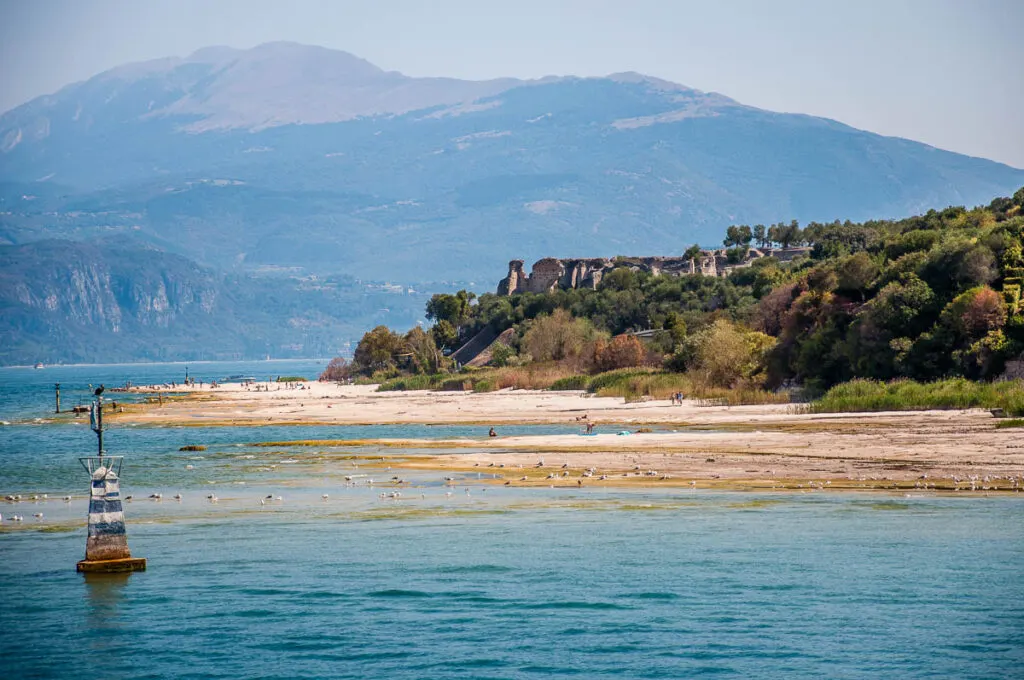
Northern Italy is blessed with some of the best beaches and mountains on this side of Europe. No matter what you are after – a hiking holiday in the hills or a relaxing stay by the sea, there are plenty of options to choose from.
In summer you are never too far away from a sparkling beach in this corner of Italy. It could be the gorgeous Ligurian beaches or the sandy beaches on the Adriatic coast with their endless lines of colourful umbrellas and sun loungers. It could be a pebbly lake beach or a wild beach where the locals congregate to cool off during the hottest days of July and August.
At the same time, Northern Italy’s mountains – the Alps, the Dolomites, and the northern portion of the Apennines – provide great opportunities to relax and to keep active. Right in the bosom of nature, you can take it easy with light walks and panoramic views or engage in many different sports – from paragliding in summer to snowboarding in winter.
Even better, in Northern Italy, you can combine beach and mountain within the same holiday. With short travel distances and a great variety of nature, you can spend time sunning yourself by the water and then hiking in the hills or vice-versa.
For example, if you book a summer vacation on the beaches of Jesolo near Venice, you can then enjoy a day trip to the Dolomites. Or, if you head to the beaches of Rimini, just down the road you can explore the hilltop Republic of San Marino. And if you stay at Lake Garda, Lake Como, or Lake Caldonazzo, you can literally do beach and mountain on the same day.
Even if you visit Northern Italy during the cold season, you can still have the best of both worlds – water and heights. Dozens of spa resorts here have amazing swimming pools fed by hot natural springs. Often, these spa resorts or even spa towns are next door to hilly groups. A case in point are the Euganean Hills in the Northern Italian region of Veneto. A short distance away from Padua and Venice, you can spend time here taking advantage of the warm natural springs and then exploring the lush hills.
Practical Tips:
If beaches and mountains are on your travel list for Northern Italy, don’t forget to bring suncream, insect repellent, adequate shoes, and appropriate clothing. In summer, the sun is very strong and mosquitoes can be relentless. Protecting your skin can be the difference between a great and a miserable holiday.
Good, comfortable shoes with a grip are paramount if you go hiking. Make sure that you research well the local trails before heading out. Often, people are seduced by the idea of taking photos of a beautiful place and then they try to hike to it without suitable shoes and gear. Always put safety first and pick a hike according to your abilities. Don’t bring small children to trails that are not suitable for them.
There are so many wonderful and beautiful corners to explore in the mountains and hilly groups of Northern Italy that there is no need to fixate on a particular spot just because it is popular on Instagram. Next door to it there will be dozens of other stunning locations which may not require a great effort or specialist equipment to reach.
Learn More:
Beaches in Northern Italy: Top Tips for Lake Garda Beaches, 3 Unmissable Lake Garda Beaches, Giamaica Beach, Beaches Near Venice
Easy Hikes in the Dolomites: Paneveggio – The Violins’ Forest, Cadini del Brenton and Cascate della Soffia, Grotta Azzurra di Mel
Easy Hikes around Lake Garda: Tibetan Bridge, Rocca di Garda, Campo di Brenzone, Punta di San Vigilio, Madonna della Corona
Easy Hike in the Little Dolomites: The Path of the Big Trees
5. Northern Italy’s Gorgeous Lakes
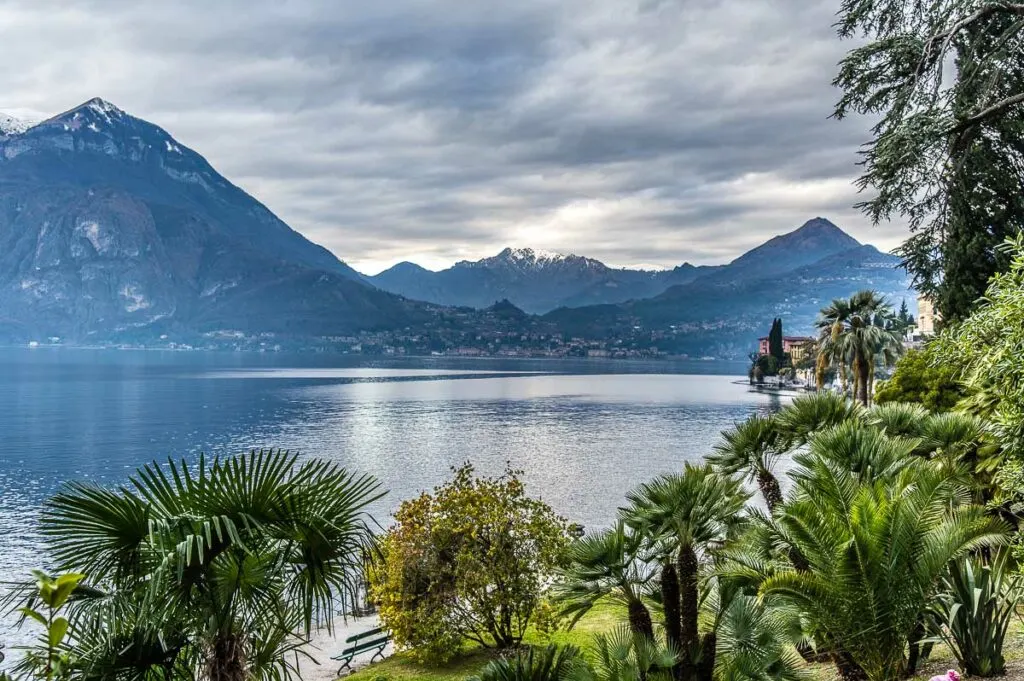
The great quartet of Italian lakes – Garda, Como, Maggiore, and Orta – sparkles brightly in the crown of Northern Italy.
With cute lakefront towns, splendid panoramic views, unique local traditions, and dozens of opportunities to sightsee and keep active, these four Northern Italian lakes attract millions of visitors each year. The best bit is that they are close to several important cities in the north of Italy and can be visited just for the day or for a longer holiday when you crave contact with nature.
As such, Milan is the gateway to Lake Como. Verona is next door to Lake Garda. Bologna and Venice are a train ride away from Lake Garda, too. Just make sure that you take the high-speed train!
You don’t have to head to the largest lakes to have a wonderful lake time in Northern Italy, though. There are hundreds of other lakes here – both big and small. From Lake Iseo which became famous for The Floating Piers installation by the late artist Christo to the surprisingly warm Lake Caldonazzo which is lovely to swim in, the choice truly is staggering.
I particularly like the tiny Lake Tenno. It has bright turquoise waters and takes about an hour to circumnavigate on foot. You will find it in the autonomous Northern Italian province of Trentino which in total has 297 lakes!
Practical Tips:
Italy’s largest and best theme parks are dotted around the southern shore of Lake Garda. Among them are Gardaland, Movieland the Hollywood Park, and Parco Cavour. Many waterparks, thermal parks, and garden parks are also here.
Northern Italy’s lakes, in general, are great for water sports, too. Lake Garda offers fantastic conditions for sailing, windsurfing, and kitesurfing. There are many beaches on its shores, too.
Swimming and water sports, however, are forbidden at some lakes here though. A case in point is the very famous Lake Sorapis. It can be reached only via a long, arduous hike in the Dolomites. It’s incredibly cold and has a stunning milky blue colour. Swimming and dipping here are not allowed to protect the lake’s fragile ecosystem.
If you visit a Northern Italian lake where sports and swimming are not allowed, please, respect the restrictions. They are in place to protect both nature and human lives. Plus, steep fines are in place to deter infringers.
Learn More:
Lake Garda: Best Sights, Best Towns, How to Navigate the Lake, Theme Parks, Beach Tips, Best Beaches, Giamaica Beach, Desenzano del Garda, Lazise, Malcesine, Riva del Garda, Torri del Benaco, Punta di San Vigilio, Campo di Brenzone
Lake Como: Travel Guide, Best Towns, Best Things to Do, How to Navigate the Lake, Best Airports, Milan to Lake Como, The Beauty of the Lake, Nesso
Other Lakes in Northern Italy: Lakes in Trentino, Lakes in Veneto
6. Northern Italy’s So Many Hidden Gems
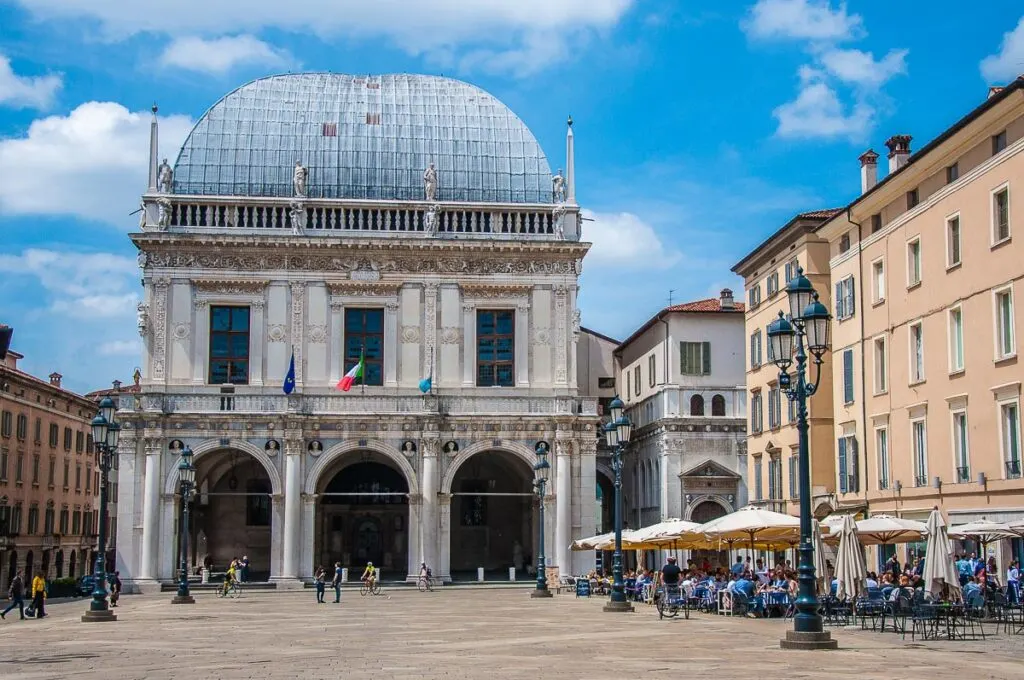
This is my favourite thing about Northern Italy as a travel destination. There is so much to do and see here off the beaten track. It’s absolutely amazing and very inspiring!
While everyone has heard of Venice and Milan, Verona and Bologna, Lake Como and Lake Garda, Cinque Terre and the Dolomites, there are hundreds more corners to explore and fall in love with in the north of Italy. Not to mention the dozens of incredibly beautiful historic villages, the many nature reserves, Italy’s longest river – Po, Italy’s shortest river – Aril, the province of Trentino with its 297 lakes, and so much more.
If you need more examples, here, in alphabetical order, are five of my favourite ones:
Brescia – halfway between Milan and Verona, this must be Northern Italy’s most underrated city. With rich layers of history that span 3,200 years, come here for monumental Roman ruins, a hilltop medieval castle, and splendid squares with Renaissance and Modernist architecture.
Chioggia – Spread on a handful of small islands on the southern edge of the Venetian Lagoon, this picturesque town was once a rival of Venice. Free of maddening crowds and with amazing beaches next door, the local dishes based on fresh seafood make Chioggia a must-see yet little-known place.
Ferrara – one of Italy’s most important Renaissance destinations, this small city has a picture-perfect historic centre and an imposing castle surrounded by a deep moat.
Lake Iseo – halfway between Lake Garda and Lake Como, this is a spectacular lake surrounded by mighty mountains and with shores dotted by cute little towns. Hosting one of Europe’s largest lake islands – the picturesque Monte Isola – Lake Iseo is also where you will find pristine nature and whimsical landforms. The Torbiere del Sebino Nature Reserve with its white waterlilies and the Zone Pyramids are two of them.
Val Camonica – a large valley in the Central Alps, here you can see one of the world’s largest collections of prehistoric rock drawings. This was Italy’s first UNESCO World Heritage Site and you can easily reach it from Brescia, Verona, and Milan.
Northern Italy has hundreds of little-known gems. The best bit is that here you don’t even need to dig deep or travel far to come across wonderful places that are rich in history, architecture, nature, and art.
Practical Tips:
One of the easiest and quickest ways to discover unique and inspiring destinations in Northern Italy is to head to its medieval villages and walled towns. With a history that spans many centuries, often commanding beautiful panoramic views, and preserving impressive defensive walls and castles, they are a delight to explore and spend time at.
These are also places where you will come in touch with ancient traditions and where you can savour delicious local foods.
I wholeheartedly recommend the walled town of Cittadella, the medieval hamlet of Borghetto sul Mincio, and smaller cities and towns like Ravenna, Comacchio, Vicenza, Este, and Montagnana. Each one of them – small, compact, and easy to explore on foot – has a tremendous richness of architecture, history, and art. Yet, they are little known by the tourist masses and you can enjoy their beauty in peace.
Learn More:
Small Towns in Veneto, Cities and Towns in Lombardy, Adventures in Veneto, Villages in Emilia-Romagna, Villages in Friuli Venezia Giulia, Villages in Veneto, Colourful Places in Veneto, Mysterious Places in Veneto
7. Northern Italy’s Musical Heritage
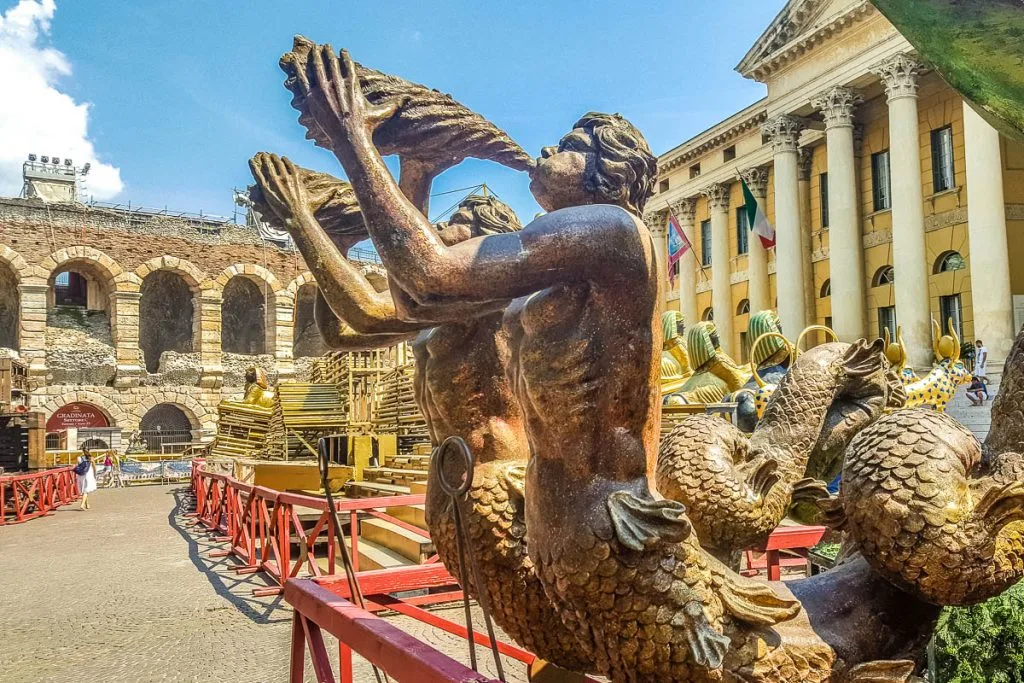
Northern Italy also has lots to offer to those who love music and want to dedicate time to extraordinary music experiences.
Some of the world’s most lavish historic opera theatres are here. From La Scala in Milan to La Fenice in Venice, you can watch splendid performances in lavish surroundings. The world’s most famous opera festival takes place every summer in the ancient Roman Arena in Verona. Listening to world-class singers whilst sitting under a starry sky on 2,000 years old stone benches is a memory that stays with you forever.
Museums dedicated to musical instruments and their history are also dotted all over Northern Italy. The most famous of them all must be the Violin Museum in Cremona. This small Northern Italian city is also where you can see historic luthier workshops where violins and other string instruments have been made by hand for decades and centuries.
You can get closer to music in many different ways in Northern Italy. Music festivals take place here regularly all throughout the year. There is something for everyone – from classical performances to pop, rock, and alternative concerts by some of the greatest names in today’s music.
In Northern Italy, you can also visit the historic homes of some of the world’s greatest composers and singers. For example, Giuseppe Verdi’s birth house near the city of Parma in the region of Emilia-Romagna. A short drive away is the elegant Villa Verdi where the composer spent the last years of his life. Near Modena, also in Emilia-Romagna, you can visit the house museum of the great Italian tenor Luciano Pavarotti.
And when you crave peace and quiet, you can still be close to music in Northern Italy. A great experience, for example, is to visit the Violins Forest in the Dolomites. For centuries, this lush, deep forest has been providing the wood for prized instruments. They say that even Stradivari would get the wood for his famous violins from here.
Practical Tips:
Attending a concert or a performance in Northern Italy’s lavish opera houses is a great experience. Alternatively, you can visit them during the day when they open their doors to be explored just like museums. Milan’s La Scala and Venice’s La Fenice are particularly beautiful. And, usually, you can simply walk in off the street and admire the splendid foyer and the frescoed cafe of Teatro Grande in Brescia where a handwritten letter by the composer Puccini hangs on the wall.
Churches, basilicas, and cathedrals are another venue to head to for exquisite music performances in Northern Italy. The Christmas and Easter concerts in Venice’s Basilica dei Frari and Milan’s Duomo are a heartfelt experience. Plus, the Duomo’s Music Chapel is Milan’s oldest cultural institution and it has been active since 1402.
In Venice – the birthplace of the famous composer Antonio Vivaldi – you can also enjoy a concert of Baroque music or a performance of his Four Seasons.
Learn More:
Paneveggio – The Violins’ Forest, A Postcard from Cremona
8. Northern Italy’s Exceedingly Delicious Food and Culinary Traditions

Northern Italy has eight regions and each one of them has its own traditional cuisine.
No! Scratch that! Northern Italy has eight regions, 47 provinces, dozens of large cities, countless towns and villages. And you can say that each one of them has a dish that’s unique to it and exquisite culinary traditions that took shape over the course of many centuries.
Millions of people travel to Italy each year eager to have the best pizza and pasta in their lives. Northern Italy offers so much more than that. So, dial-up your culinary expectations and get your taste buds ready to savour:
- polenta in many different variations and applications (it’s not in vain that the Northern Italians are known as polentoni!)
- love-knot tortellini from Valeggio sul Mincio which also have a romantic legend attached to their origin;
- Vicenza’s baccala’ alla vicentina – a dish that was born as a result of one of Europe’s oldest food routes;
- pumpkin tortelli from Mantua – a delicacy with medieval roots;
- prosciutto berico-euganeo DOP from the town of Montagnana – officially recognised as one of the best dry-cured hams in all of Italy, it even has a Protected Designation of Origin (DOP) status;
- coppa Piacentina DOP – thinly sliced cured meat which is produced exclusively in the area around the Northern Italian city of Piacenza;
- strudel from Trentino-South Tyrol and also from Veneto where the wide availability of several Austrian cakes and desserts testify to the historical events in these lands;
- mandorlato from Cologna Veneta and torrone from Cremona – a Christmas nougat made of egg whites, sugar, honey, and almonds.
Even Northern Italian foods, dishes, and desserts that are known all over the world have so many more nuances to them in the actual places where they were first created. Treviso’s tiramisu, Milan’s panettone, Verona’s pandoro, Parma ham (Prosciutto di Parma), and Parmesan cheese (Parmiggiano Reggiano) are only some of the applicable examples.
Eating is not the only way to experience the rich culinary traditions of Italy’s north. Once here, you can also take a cooking class, visit a sagra (a local food event), explore a winery, spend time at an agriturismo (an independent farm), browse food markets that have been held at the same spot for centuries, book food tours, visit producers specialised in a particular delicacy, embrace sweet breakfasts, enjoy proper Italian aperitivo, explore culinary libraries (read here about the one in Vicenza), enjoy chocolate festivals, and get close to the Northern Italian food traditions in so many more different ways.
Practical Tips:
Food, coffee, and wine are a big component of the culture of Northern Italy. To fully experience this wonderful place, be ready to taste and savour the local dishes and drinks while learning the stories behind them.
From the coffee shops of Venice – the first city in Europe to commercially import coffee in the 16th century – to the chocolate companies of Turin – where some of Italy’s and the world’s most popular chocolates were invented (Ciao, Nutella!), there is lots to eat and drink in the north of Italy.
The best tip I can give you is to be curious and be ready to taste something new every day here. Leave preconceptions about what Italian food should look and taste like and embrace the local flavours and culinary delights of Northern Italy.
Learn More:
Breakfast: Rules of Italian Breakfast, Italian Breakfast Foods
Food: Italian Markets, Cheap Eats in Italy, The Food of Lake Garda, 10 Reasons to Eat Polenta, Traditions of Panettone, Italian Cheeses, Mandorlato Veneto, Italian Food Gifts, Venetian Frittella, Pasticceria Soraru, Castagnata, Caperberries
Italian Coffee: Italian Coffee Culture, Italian Coffee Drinks, History of Coffee in Italy
9. Northern Italy’s Hundreds of Opportunities to Keep Active
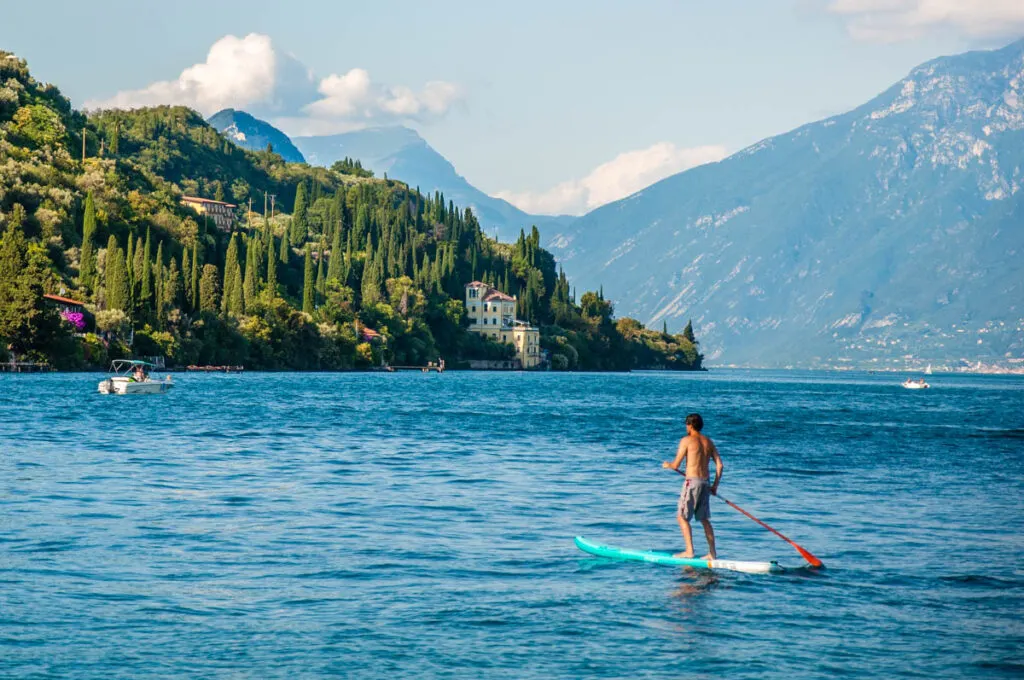
Northern Italy is a great destination to head to if you like to keep active. The Italians love sports. Cycling and hiking are especially popular. Children start to cycle from an early age. Many adults cycle to work every day and spend time in the bosom of nature on weekends. In winter, skiing, snowboarding, and snowshoe walking are the order of the day.
Being outdoors, exercising, and practising dozens of different sports is not a difficult feat in Northern Italy. You can either dedicate your whole holiday here to sport and exercise or alternate sightseeing and relaxation time with physical activities.
In summer, you can pick from Nordic walking, horse-riding, forest bathing, hand-gliding, swimming, paddleboarding, and windsurfing (to mention but a few of the many different options). In winter ski resorts abound.
Even if you prefer to be a sports spectator rather than an active participant, you are still in luck in Northern Italy. From football matches and stadium tours to the forthcoming Winter Olympics in 2026, there is something for everyone who enjoys watching competitive sports.
And if you prefer your sports with a touch of history, then head straight to Venice. Rowing and sailing regattas inspired by historic events are held here several times throughout the year. Especially popular are the Regatta Storica each September and the Regatta of the Historic Maritime Republics which takes place in Venice once every four years.
Practical Tips:
Northern Italy’s lakes are wonderful destinations for anyone who loves water sports. Lake Garda and Lake Como, for example, are two of the best spots for windsurfing and kitesurfing in Europe. There are many sailing clubs here that hold regattas throughout the year.
Dozens of winter resorts are dotted all over Northern Italy. Aosta Valley and Trentino-South Tyrol are particularly good destinations for snow sports. Yet, you will find great pistes in Asiago and Monte Baldo in Veneto, Val Camonica and Val Trompia in Lombardy and many more Northern Italian destinations.
10. Northern Italy’s Excellent Shopping
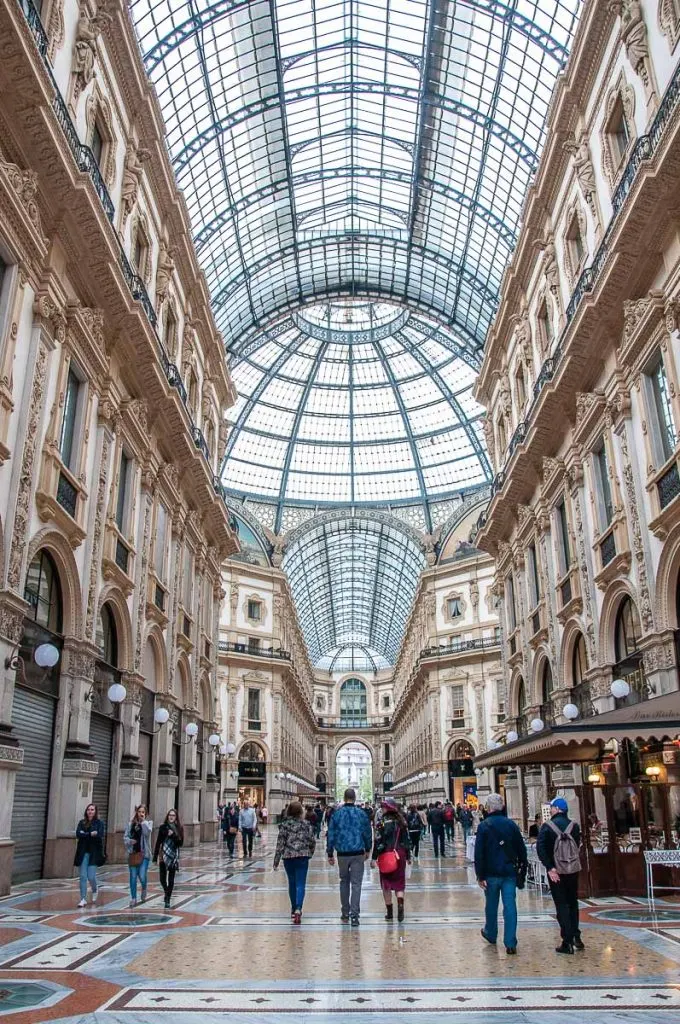
Northern Italy is a great place to visit if you like to shop.
Many renowned Italian brands – both high fashion and high-street – have their headquarters and factories here. The fashion capital Milan has the stunning Galleria Vittorio Emanuele II. Pictured above, it’s considered to be Italy’s oldest active shopping mall.
Several large outlet villages operate near important Northern Italian cities like Venice, Turin, and Brescia. This is where you can shop for branded products at significant discounts:
- Serravalle Outlet Village with more than 230 shops in Piedmont;
- Franciacorta Outlet Village with more than 160 boutiques in Lombardy;
- Noventa di Piave Designer Outlet with over 150 shops in Veneto; and
- Fidenza Village with more than 120 boutiques in Emilia-Romagna and with easy access from Lombardy, too.
In addition, large shopping centres stand on the outskirts of the main Northern Italian cities and towns. Inside them, you will find hundreds of shops selling the latest fashions, stylish homewares, Italian jewellery, and anything else, really.
And that’s not all!
Northern Italy is where you will find some of the best artisans and most exquisite craft products in Europe. From the masters of Murano glass in the Venetian Lagoon and the jewellers of Vicenza to the violin-makers of Cremona and the pottery-makers of Faenza, Nove, and Bassano del Grappa, there are hundreds of artisan workshops here to visit, explore, and acquire unique pieces from.
Practical Tips:
If shopping is serious business for you, then try to visit Italy during its annual sales. Traditionally, they take place twice a year – once at the start of January and then again in June/July. This is when shops offer great discounts and you can shop til you drop.
In Conclusion
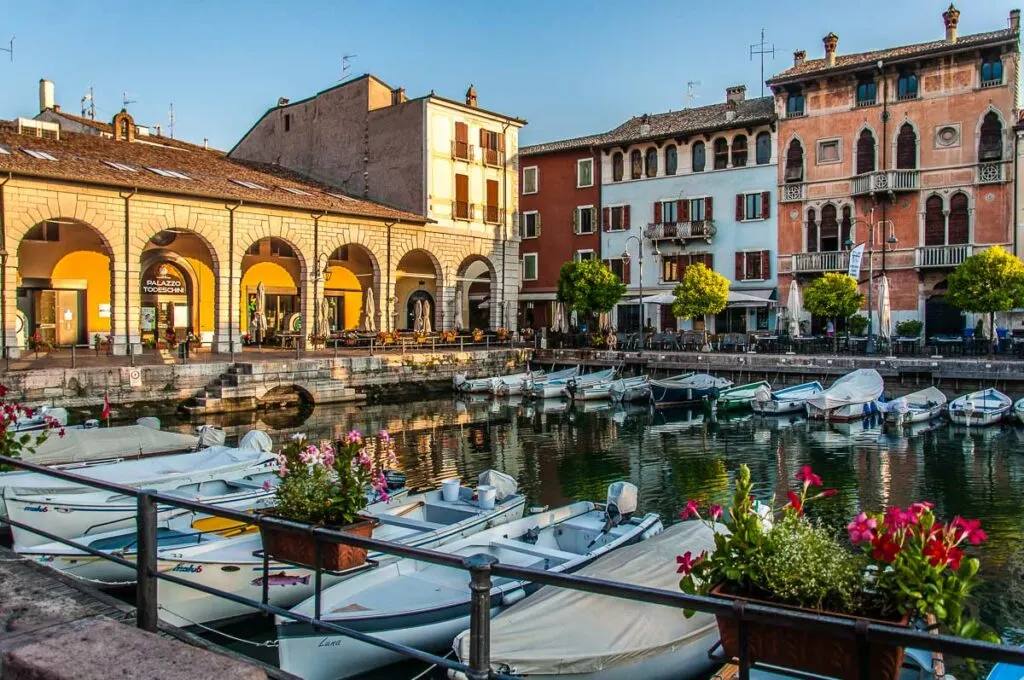
Northern Italy has a lot to offer to the traveller seeking to have a wonderful and memorable holiday. A land with a millennial history, beautiful nature, and a rich catalogue of art, this is a corner of Italy that has to be visited at least once in a lifetime.
Easy to reach by plane, train and car from anywhere in Europe and with a well-developed public transport network, Northern Italy has many cities and towns that are wonderful destinations for short breaks and long holidays. If you are looking for a new and intriguing place to visit, in this blog post I gave you ten reasons why the north of Italy may just be it.
From music and art to exceedingly delicious food and adrenaline sports, from mountains and lakes to beaches and hills, from museums and landmarks to large theme parks, there is something for everyone here to enjoy. I hope that all the first-hand tried and tested information shared herewith as well as the map of the eight Northern Italian regions will help you during the planning stages of your holiday.
Have a great time in Italy’s north!
Enjoy every Northern Italian experience!
Travel Tools
Get Ready for Your Trip to Northern Italy
Get a guidebook from Amazon.
Buy plane tickets, train tickets, and bus tickets through Omio.
Rent a car from Europcar.
Research accommodation on Booking.com.
Select local tours and activities on GetYourGuide, Viator, and Tiqets.
More Helpful Information About Italy for You
Best of Italy: Italian Piazzas, Italian Markets, Accommodation for Every Budget, Best Times to Visit Italy, Italy in Summer, Italy with Kids
Italian Food: Best Italian Food Gifts, Cheap Italian Food, Rules of Italian Breakfast, Italian Breakfast Foods
Italian Coffee: Italian Coffee Culture, Italian Coffee Drinks, History of Coffee in Italy
Christmas in Italy: Fun Facts, Things to Do, Italian Nativity Scenes, Panettone, Christmas Guide
Northern Italy: Best Cities to Visit, Major Airports, Reasons to Visit
Lake Como: Ultimate Travel Guide, Best Towns, Best Things to Do, How to Get to Lake Como, Reasons to Visit in Winter, Inspiring Photos, Nesso, Milan to Lake Como
Lake Garda Towns and Villages: Best Towns, Desenzano del Garda, Lazise, Riva del Garda, Malcesine, Torri del Benaco, Punta di San Vigilio, Campo di Brenzone, Borghetto and Valeggio sul Mincio
Visiting Lake Garda: Map of Lake Garda, Getting Around Lake Garda, Food of Lake Garda, Lake Garda with Kids, 8 Best Airports, Venice to Lake Garda, Verona to Lake Garda, Milan to Lake Garda, Bologna to Lake Garda
Verona: Things to Do in One Day, Verona Opera Festival, Day Trips from Verona, Romeo and Juliet Itinerary, Verona to Venice, Verona to Milan
Padua: Things to Do in One Day, 101 Facts About Padua, 10 Reasons to Visit Padua, Day Trips from Padua
Vicenza: Things to Do, Day Trips from Vicenza, Best Museums, The Beauty of Vicenza
Veneto: Top Places to Visit, Unique Adventures, Most Colourful Places, Mysterious Places, Most Beautiful Lakes, Reasons to Visit, Main Cities, Prettiest Small Towns, Most Beautiful Villages
Lombardy: Best Cities and Towns, Reasons to Visit, Brescia
Friuli Venezia Giulia: Venzone, Most Beautiful Villages
Emilia Romagna: Bologna, Ravenna, Comacchio, Most Beautiful Villages
Marche: Reasons to Visit, Gradara, Frasassi Caves, Temple of Valadier
Umbria: Reasons to Visit Perugia
Thank you for reading! You can leave me a comment, pin the images, or use the buttons right at the top and at the end of this blog post to share it on social media.
For more useful information like this, please, like my blog’s page on Facebook and Instagram and subscribe to my strictly no-spam newsletter.
Pin This Blog Post!
